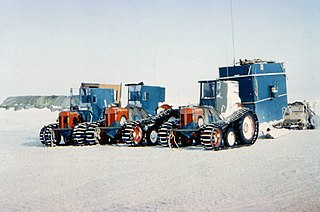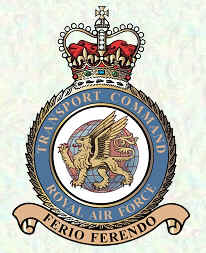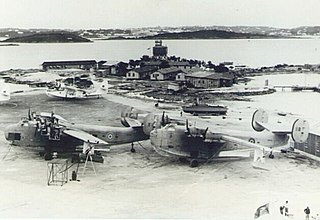The Royal Air Force Antarctic Flight was an independent flight of the Royal Air Force organised to support the Norwegian–British–Swedish Antarctic Expedition in 1949-50. It was the first RAF unit to operate in Antarctica.

A flight is a military unit in an air force, naval air service, or army air corps. It is usually composed of three to six aircraft, with their aircrews and ground staff; or, in the case of a non-flying ground flight, no aircraft and a roughly equivalent number of support personnel. In most usages, multiple flights make up a squadron. The "flight" is also a basic unit for intercontinental ballistic missiles. Foreign languages equivalents include escadrille (French), escuadrilla (Spanish), esquadrilha (Portuguese) and Schwarm (German).

The Royal Air Force (RAF) is the United Kingdom's aerial warfare force. Formed towards the end of the First World War on 1 April 1918, it is the oldest independent air force in the world. Following victory over the Central Powers in 1918 the RAF emerged as, at the time, the largest air force in the world. Since its formation, the RAF has taken a significant role in British military history. In particular, it played a large part in the Second World War where it fought its most famous campaign, the Battle of Britain.
The Norwegian–British–Swedish Antarctic Expedition (1949–1952) was the first Antarctica expedition involving an international team of scientists. The team members came from Norway, Sweden and the British Commonwealth of Nations.
The Flight was led by Squadron-Leader George Brian Walford, and had five personnel in total, selected from over 250 volunteers - two officer pilots and three non-commissioned officer mechanics. [1] It operated two Auster Mark 6 aircraft, painted orange and modified for cold-weather conditions, with convertible ski/wheel and float undercarriages. [2]

The Auster AOP.6 was a British military air observation aircraft produced by Auster Aircraft Limited to replace the numerous wartime Taylorcraft Auster aircraft then in-service.
The Flight was shipped to Antarctica from Cape Town aboard the Norsel, a Norwegian ship, in November 1949, [3] and operated from the newly established Maudheim station in early 1950, supporting the mapping of the area around the station in preparation for scientific expeditions into the continent. The aircraft were withdrawn in February 1950 and the flight was disbanded on its return to South Africa. [4] In the following seasons, air support was provided to the expedition by Norwegian aircraft. [5]

MV Norsel was a Norwegian sealing ship home ported in Tromsø. Launched during the final weeks of the Second World War as Lyngdalsfjord and only completed in late 1949, the ship sailed in both Arctic and Antarctic waters for more than 53 years until shipwrecking off the coast of Norway in 1992.
The two modified Auster aircraft were acquired by the Australian government for the Antarctic Flight RAAF in 1952, and after rebuilding work were deployed to Antarctica in the 1953/54 summer season, where both operated from Mawson station. One was lost on the return voyage, but the other served in Antarctica over a number of years until it was sold after the end of the 1958/59 season. [3]
The Antarctic Flight was a Royal Australian Air Force (RAAF) aircraft flight. It operated from RAAF Base Laverton and Mawson Station. The flight was responsible for expeditions and rescue missions in Antarctica.
Another two Austers were operated by the RAF and RNZAF (as "Auster Antarcticas") as part of the Commonwealth Trans-Antarctic Expedition in 1955-58. [4]

The 1955–58 Commonwealth Trans-Antarctic Expedition (CTAE) was a Commonwealth-sponsored expedition that successfully completed the first overland crossing of Antarctica, via the South Pole. It was the first expedition to reach the South Pole overland for 46 years, preceded only by Amundsen's and Scott's respective parties in 1911 and 1912.










